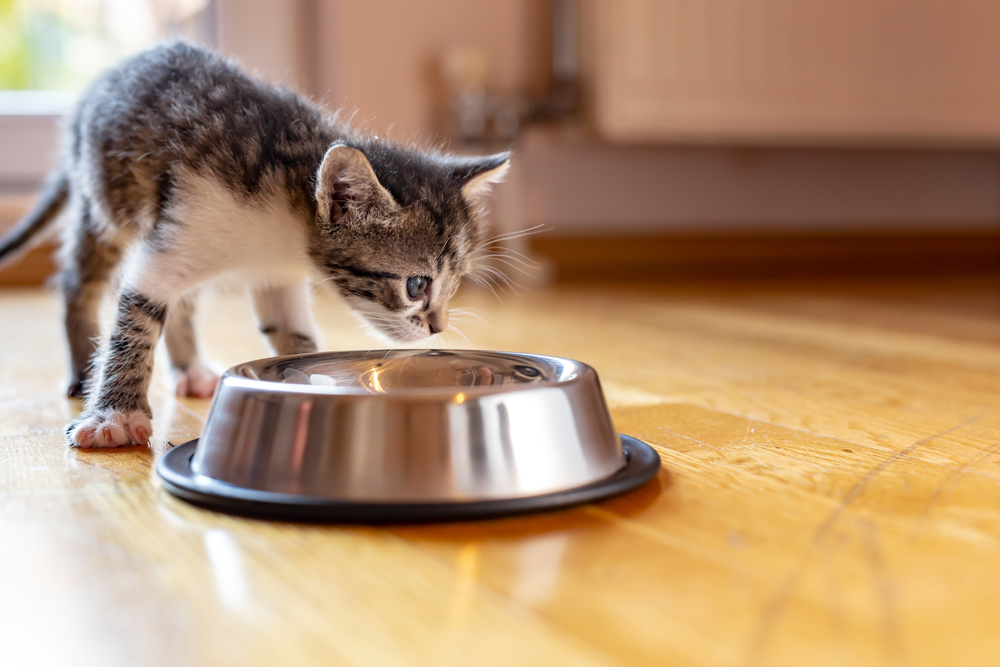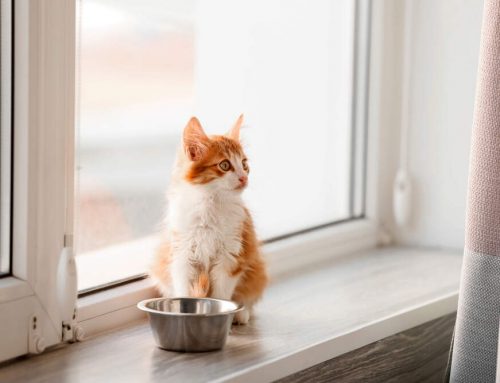Raising a kitten is a wonderful opportunity to have a warm little bundle of fluff in your home. Kittens love to play, and they make life so much fun. But sometimes, your kitten might have a few quirks that cause you to worry. Do you have a kitten that won’t eat dry food? Baby cats may need a little coaxing before they make the switch to kibble. You can help make your kitten eat dry food by mixing it with wet food, adding a little unsalted broth, or feeding the old and new foods side-by-side.
Try Mixing with Wet Food or Adding Water
If your kitten is used to eating wet food, then he may have some trouble adjusting to the drier texture or the taste of kibble. This is especially true if he’s been getting the same type of food for quite a while. He might need a little coaxing to try something new.
Some veterinarians suggest if your kitten resists switching from canned to dry food, try sprinkling a little bit of dry food over the wet food.1 Gradually switch, adding more dry food to the mixture over time. If your kitten’s still resistant when it’s mostly dry food, add some water to the kibble to change the texture a bit. You can slowly decrease the amount of water over time.
Try Adding Broth or Serving Two Foods Side-by-Side
If mixing the food isn’t working, try adding a little unsalted chicken broth to the kibble.2 Sometimes water isn’t enough, but the broth can tempt your kitten to try the dry food.
Some experts recommend serving the new and old foods side-by-side rather than mixing them.3 You can always try this first, then switch to mixing the foods if it doesn’t work. If you try the side-by-side method, serve a bowl of canned food next to a bowl of dry kibble. Slowly decrease the canned food over time and increase the kibble.
Get a Veterinarian’s Advice
On rare occasions, some kittens might not only lose their taste for dry food but for pretty much all food in general. A kitten that’s not eating much might have some health issues. If your kitten’s eating habits have changed, see your veterinarian right away.
Make Sure You’re Feeding a Food Made for Kittens
Remember, it’s very important to feed your kitten food formulated just for her young age. This is because a kitten grows fast and may have energy needs that are three times higher than an older cat.4 Kittens also need more protein, amino acids, and minerals. It’s good to feed specially formulated kitten food until she’s about one-year-old. And of course, don’t forget to provide plenty of water.
A great dry food formulated especially for kittens is the Chicken & Herring Meal Kitten Formula by AvoDerm Natural. This food has high-quality ingredients, including avocados, with protein, fat, and nutrients balanced just right for kittens. The formula also includes DHA for healthy development.
Wet Food Is Okay
Wet food is perfectly okay to feed your kitten if he really won’t make the switch to dry.5 In fact, very young kittens may still need some canned food because of their small teeth. If you feed him only canned kitten food, you probably need to feed him four times a day but check the directions to know for certain.
Always Switch Food Slowly
Any time you switch a cat’s food—whether an adult or a kitten—you want to change the food gradually because cats have sensitive stomachs. Switching to a different food overnight can make their stomachs really upset, so make the change slowly.
However, don’t be shy about letting your kitten try different kinds of food and different flavors over time.6 Giving your kitten a variety of choices, while still serving the food she’s familiar with, can help make sure she doesn’t grow up to be a super finicky eater.
Some kittens might be nervous about the texture of dry food, but with a little patience, you can teach your kitten to eat dry kibble. Before long, you’ll have a happy little cat nomming down on delicious kitten food.
1. Olsen, Jenna. “How to Switch a Small Kitten from Canned Food to Dry Food.” YouTube.com, 15 October 2013, https://www.youtube.com/watch?v=YmOr-4-elqs.
2. Dr. Melanie. “My Kitten Doesn’t Eat the Dry Food at All.” PetCoach, https://www.petcoach.co/question/?id=184650.
3. Stuart, Annie. “Feeding Kittens: What, When, How Much.” Pets.WebMD.com, 27 April 2012, https://pets.webmd.com/cats/guide/feeding-your-kitten-food-and-treats#1.
4. Eckstein, Sandy. “How to Deal with a Cat That’s a Picky Eater.” Pets.WebMD.com, 8 July 2009, https://pets.webmd.com/cats/guide/how-to-deal-with-a-cat-thats-a-picky-eater#1.





